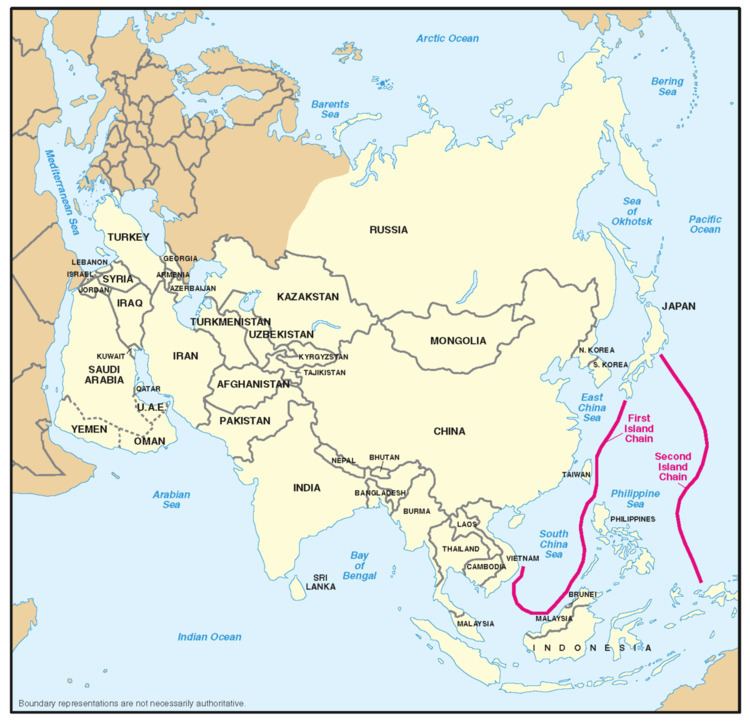 | ||
The China containment policy is a political term referring to a claimed goal of U.S. foreign policy to diminish the economic and political growth of the People’s Republic of China. The term harkens back to the U.S. containment policy against communist countries during the Cold War.
Contents
The theory asserts that the United States needs a weak, divided China to continue its hegemony in Asia. This is accomplished by the United States establishing military, economic, and diplomatic ties with countries adjacent to China's borders, frustrating China's own attempts at alliance-building and economic partnership. The presence of American military in Afghanistan, Uzbekistan, and Tajikistan; recently strengthened ties with South Korea and Japan; efforts to improve relations with India and Vietnam; and the Obama administration's 2012 Pivot to Asia Strategy for increased American involvement in the Pacific have been pointed to as evidence of a containment policy. The United States has officially claimed they have no China containment policy and that they "want China to succeed and prosper."
Justification
Supporters of Chinese containment or increased American involvement in East Asia have cited the United States as a counterbalance to the excesses of Chinese expansion. Countries in territorial disputes with China, such as in the South China Sea and the Senkaku Islands, have complained about harassment in the disputed areas. Some experts have suggested that China may leverage their economic strength in such disputes, one example being the sudden restriction on Chinese imports of Filipino bananas during tensions over the Scarborough Shoal.
The 2006 U.S. National Security Strategy states that China has 'the greatest potential of any nation to militarily compete with the US and field disruptive military technologies that over time offset traditional US advantages.' The document continues by stating that China must be more open in reporting its military expenditures and refrain from "locking up" energy supplies by continuing to obtain energy contracts with disreputable regimes in Africa and Central Asia. The policy assumes that measures should be taken against China to prevent it from seeking hegemony in the Asia-Pacific region and/or worldwide.
Strategic alliances
US–India: (See India–United States relations) It is assumed was established or reconfirmed during Bush’s visit to India in March 2006. The media speculated about the US using India to contain China, claims that the Indian officials publicly denied.
US–Japan–Australia: (See Japan–United States relations and Australia–United States relations) Labeled by the Asian media as a "little NATO against China" or the new "triple alliance", or "the axis of democracy" by the Economist. Condoleezza Rice’s visit to Australia in March 2006 for the "trilateral security forum" with the Japanese foreign minister Taro Aso and his Australian counterpart Alexander Downer.
Japan–Australia: (See Australia–Japan relations) On March 15, 2007 both nations signed a strategic military partnership agreement, which analysts believe is aimed at alienating China.
US–Japan–Australia–India: In May 2007, the four nations signed a strategic military partnership agreement – the Quadrilateral Security Dialogue.
US–Japan–India: The three nations held their first trilateral meeting in Dec 2011.
Challenges
Australia: Australia has a growing dependency on China’s market. Its mining industry is booming owing to Chinese demand. During the second Bush Administration, ahead of the visit by Condoleezza Rice and her warning about China becoming a "negative force" the then Australian Foreign Affairs Minister, Alexander Downer, warned that Australia does not agree with a policy of containment of China. Rice clarified that the U.S. is not advocating a containment policy.
India: China is India's largest trading partner. George W. Bush’s visit to India was seen in part as an attempt to boost bilateral trade and to expand US influence, by offering India high nuclear technology. China is the United States' fifth-largest trading partner in terms of exports, while India ranks only twenty-fourth.
Japan: China has overtaken the US as Japan’s largest trading partner.
